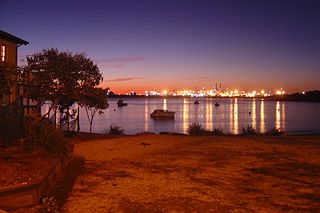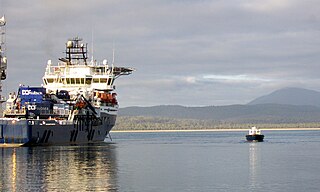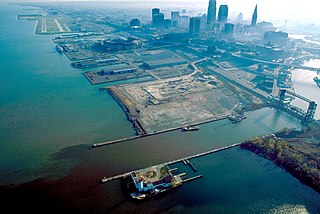
The Port of Felixstowe, in Felixstowe, Suffolk, is the United Kingdom's largest container port, dealing with 48% of Britain's containerised trade. In 2017, it was ranked as 43rd busiest container port in the world and 8th in Europe, with a handled traffic of 3.85 million twenty-foot equivalent units (TEU). In 2019 it was ranked the UKs 7th busiest port.

The Port of Melbourne is the largest port for containerised and general cargo in Australia. It is located in Melbourne, Victoria, and covers an area at the mouth of the Yarra River, downstream of Bolte Bridge, which is at the head of Port Phillip, as well as several piers on the bay itself. Since 1 July 2003, the Port of Melbourne has been managed by the Port of Melbourne Corporation, a statutory corporation created by the State of Victoria.

Jurong Port Pte Ltd is a port operator headquartered in Singapore. Jurong Port, which operates the only multi-purpose port in Singapore, handles bulk, break-bulk and containerised cargo. It handled over 40,000 vessel-calls annually in 2019.

The Port of Halifax comprises various port facilities in Halifax Harbour in Halifax, Nova Scotia, Canada. It covers 10 km2 (3.9 sq mi) of land, and looks after 150 km2 (58 sq mi) of water.

Port Botany is a suburb in the Eastern Suburbs of Sydney, in the state of New South Wales, Australia. Port Botany is located 12 kilometres south of the Sydney central business district, in the local government area of the City of Randwick. Port Botany sits on the northern shore of Botany Bay, adjacent to the suburbs of Matraville, Banksmeadow and Phillip Bay.

Port of Brisbane is the shipping port and coastal suburb of the City of Brisbane, on the east coast of Queensland, Australia. In the 2016 census, Port of Brisbane had no residents living in the suburb.

The Port of Karachi is one of South Asia's largest and busiest deep-water seaports, handling about 60% of the nation's cargo located in Karachi, Pakistan. It is located on the Karachi Harbour, between Kiamari Azra Langri, Manora, and Kakapir, and close to Karachi's main business district and several industrial areas. The geographic position of the port places it in close proximity to major shipping routes such as the Strait of Hormuz. The administration of the port is carried out by the Karachi Port Trust, which was established in 1857.

White Bay is a bay on Sydney Harbour with a surrounding locality near the suburbs of Balmain and Rozelle in the Inner West of Sydney, New South Wales, Australia.
The Port of Montreal is a cruise and transshipment point. It is located on the St. Lawrence River in Montreal, Québec, Canada. The port operates as an international container port. It services Toronto, the rest of Central Canada, the Midwestern United States, and the Northeastern United States. Though found on the Saint Lawrence Seaway, it is some 1,600 miles (2,600 km) inland from the Atlantic Ocean and it is on the shortest direct route between the North American Midwest and Europe or the Mediterranean.
International Container Terminal Services, Inc. (ICTSI) is a global port management company headquartered in Manila, Philippines. Established on December 24, 1987, ICTSI is the Philippines' largest multinational and transnational company, having established operations in both developed and emerging market economies in Asia Pacific, the Americas, and Europe, the Middle East and Africa. The company is ranked the eighth largest container terminal operator, according to TEU equity volume.

Barangaroo is an area of central Sydney, New South Wales, Australia. It is located on the north-western edge of the Sydney central business district and the southern end of the Sydney Harbour Bridge. It is part of the local government area of the City of Sydney. The area was used for fishing and hunting by Indigenous Australians prior to colonial settlement. The area is inclusive of The Hungry Mile, the name harbourside workers gave to the docklands area of Darling Harbour East during The Great Depression, where workers would walk from wharf to wharf in search of a job, often failing to find one.

The Port of Málaga is an international seaport located in the city of Málaga in southern Spain, on the Costa del Sol coast of the Mediterranean. It is the oldest continuously-operated port in Spain and one of the oldest in the Mediterranean.

The Port of Eden is a small seaport situated in Twofold Bay, adjacent to the town of Eden, located in the South Coast region of New South Wales, Australia.

The Port of Cleveland is a bulk freight and container shipping port at the mouth of the Cuyahoga River on Lake Erie in Cleveland, Ohio, United States. It is the third-largest port in the Great Lakes and the fourth-largest Great Lakes port by annual tonnage. Over 20,000 jobs and $3.5 billion in annual economic activity are tied to the roughly 13 million tons of cargo that move through Cleveland Harbor each year.

Fremantle Harbour is Western Australia's largest and busiest general cargo port and an important historical site. The inner harbour handles a large volume of sea containers, vehicle imports and livestock exports, cruise shipping and naval visits, and operates 24 hours a day. It is located adjacent to the city of Fremantle, in the Perth metropolitan region.

The Port of Odesa or Odesa Sea Port, located near Odesa, is the largest Ukrainian seaport and one of the largest ports in the Black Sea basin, with a total annual traffic capacity of 40 million tonnes, the only port of Ukraine capable of accepting Panamax class vessels. The port has an immediate access to railways allowing quick transfer of cargo from sea routes to ground transportation. Along with its younger satellite ports of Chornomorsk (1958) and Yuzhne (1973), the Port of Odesa is a major freight and passenger transportation hub of Ukraine.
Hutchison Port Holdings Limited, trading as Hutchison Ports, is a private holding company incorporated in the British Virgin Islands. The port operator group is a subsidiary of CK Hutchison Holdings. Some operation of the company were listed as Hutchison Port Holdings Trust in Singapore Exchange.

The Red Hook Marine Terminal is an intermodal freight transport facility that includes a container terminal located on the Upper New York Bay in the Port of New York and New Jersey. The maritime facility in Red Hook section of Brooklyn, New York City handles container ships and bulk cargo. The Port Authority of New York and New Jersey (PANYNJ) bought the piers in the 1950s when there was still much break bulk cargo activity in the port. The container terminal was built in the 1980s,

Port Kembla is a man-made cargo port or artificial harbour, with an outer harbour protected by breakwaters and an inner harbour constructed by dredging, located in the Illawarra region of New South Wales, Australia.

The Port Authority of New South Wales, is a corporation owned by the Government of New South Wales, Australia. It acts as harbourmaster at the state's six commercial seaports, managing shipping movements, safety, security and emergency response. While major cargo handling facilities are operated by the private sector, the Port Authority continues to manage smaller facilities including Sydney's two cruise terminals, at Circular Quay and White Bay; common user berths at Sydney's Glebe Island and White Bay; and the regional ports at Eden and Yamba.



















